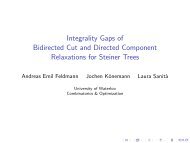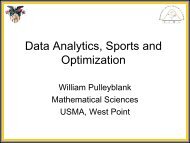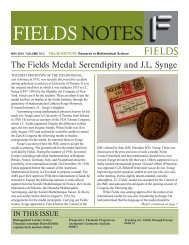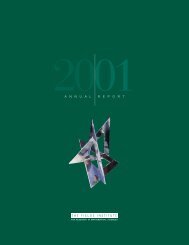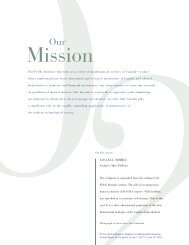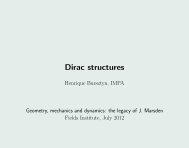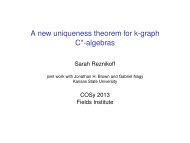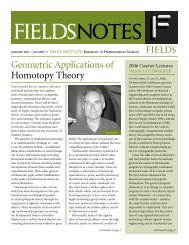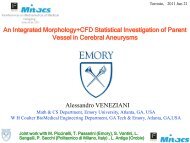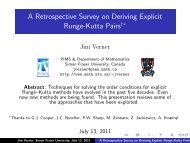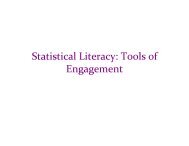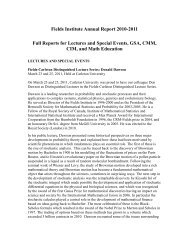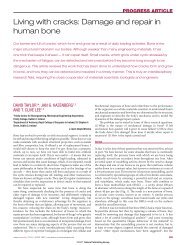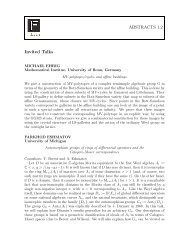Annual Report 2005 - Fields Institute - University of Toronto
Annual Report 2005 - Fields Institute - University of Toronto
Annual Report 2005 - Fields Institute - University of Toronto
Create successful ePaper yourself
Turn your PDF publications into a flip-book with our unique Google optimized e-Paper software.
The seventh annual GLGC, which was co-sponsored by<br />
<strong>Fields</strong> and Perimeter <strong>Institute</strong>s, and the <strong>University</strong> <strong>of</strong><br />
Waterloo, included nearly 60 participants, mostly mathematicians<br />
but also a few physicists. Ronald Fintushel<br />
delivered a welcoming speech, and what followed were<br />
nine excellent talks that detailed progress on a number <strong>of</strong><br />
important problems in geometry and topology.<br />
Research in geometry is fueled in great part by physics, and<br />
this was evident in the talks. For example, Gukov’s talk<br />
used an analogy with string theory to motivate an ongoing<br />
search for an overarching triply-graded homology <strong>of</strong> knots<br />
that will unify different knot homologies in much the same<br />
way that M-theory unified the different string theories<br />
in physics. Another example <strong>of</strong> the pervasive influence <strong>of</strong><br />
physics in geometry was Stipsicz’s talk, which outlined the<br />
construction <strong>of</strong> exotic smooth structures on the five-time<br />
blow-up <strong>of</strong> complex projective plane and the application<br />
<strong>of</strong> Seiberg-Witten gauge theory in proving exoticness.<br />
Other topics included conformal compactification and<br />
general relativity, contact homology and cusped flow trees,<br />
Gromov-Witten and Donaldson-Thomas invariants, Hamiltonian<br />
dynamics and Floer homology, loop groups and<br />
models for equivariant K-theory and cohomology, Ricci<br />
curvature for metric measure spaces, and Toeplitz operators<br />
and quantization.<br />
On Saturday evening, conference participants were treated<br />
to a banquet dinner in the Black Hole Bistro followed by a<br />
delightful classical music concert performed by the Perimeter<br />
Ensemble and hosted by the inimitable Tom Allen (CBC<br />
Radio). On Sunday afternoon, conference participants were<br />
given a guided tour <strong>of</strong> the Perimeter <strong>Institute</strong>. Thanks to<br />
the diligence <strong>of</strong> Perimeter’s IT staffs, a DVD <strong>of</strong> the talks can<br />
be ordered from the organizers.<br />
Geometry Conference group<br />
G e n e r a l S c i e n t i f i c A c t i v i t i e s<br />
Speakers:<br />
Michael Anderson (New York at Stony Brook)<br />
Conformal compactification in Riemannian geometry and<br />
general relativity<br />
Kai Behrend (UBC)<br />
Towards an understanding <strong>of</strong> Donaldson-Thomas invariants<br />
in terms <strong>of</strong> Euler characteristics<br />
John Etnyre (Pennsylvania)<br />
Cusped flow trees and contact homology<br />
Tatyana Foth (UWO)<br />
Toeplitz operators, automorphic forms, and quantization<br />
Sergei Gukov (Clay Math)<br />
The superpolynomial for knot homologies<br />
Francois Lalonde (Montreal)<br />
Hamiltonian dynamics and a universal Floer homology<br />
John Lott (Michigan)<br />
Ricci curvature for metric-measure spaces<br />
Eckhard Meinrenken (<strong>Toronto</strong>)<br />
Small models and twisted differentials<br />
Andras Stipsicz (Alfred Renyi Inst. <strong>of</strong> Math)<br />
Exotic smooth structures on rational surfaces<br />
Workshop on Numerical and Analytic Methods in Fluid<br />
Dynamics<br />
May 5–7, <strong>2005</strong><br />
Held at Carleton <strong>University</strong><br />
Organizers: David Amundsen and Lucy Campbell (Carleton)<br />
The study <strong>of</strong> fluid dynamics has driven the development <strong>of</strong><br />
numerous fundamental analytic and numerical methods<br />
<strong>of</strong> applied mathematics. As the sophistication <strong>of</strong> physical<br />
models increases and the scope <strong>of</strong> applications expands,<br />
the impetus for further developments is as great as ever.<br />
This three day workshop, funded by <strong>Fields</strong> and MITACS,<br />
brought together researchers from both <strong>of</strong> these essential<br />
sides <strong>of</strong> applied mathematics. It provided the opportunity<br />
to share in the latest developments, and foster new collaborations<br />
and avenues <strong>of</strong> research. In total there were over 28<br />
participants including 18 students.<br />
<strong>Fields</strong> <strong>Institute</strong> <strong>2005</strong> ANNUAL REPORT 74



